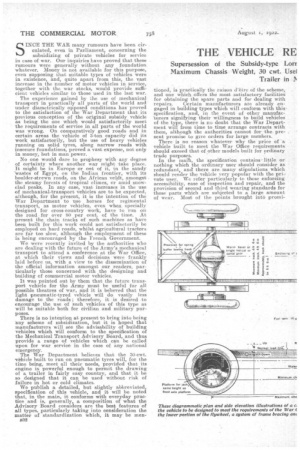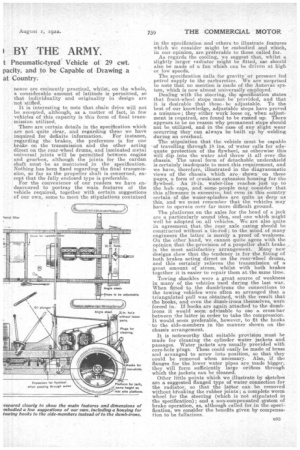THE VEHICLE RE BY THE ARMY.
Page 16

Page 17

If you've noticed an error in this article please click here to report it so we can fix it.
SIINCE THE WAR many rumours have been circulated, even in Parliament, concerning the subsidizing of private vehicles for service in case of war. Our inquiries have proved that these rumours were generally without any foundation whatever. Money is not available for this purpose, even supposing that suitable types of vehicles were in existence, and, quite apart from this, the vast•increase in the number of motor vehicles in service,
together with the war stocks, would provide sufficient vehicles similar to those used in the last war.
The experience gained by the use of mechanical transport in practically all parts of the world and u.nder diametrically opposed conditions has proved to the satisfaction of the War Department that its previous conception of the original subsidy vehicle as being the one which would satisfactorily meet the requirements of service in all parts of the world was wrong. On comparatively good roads and in certain areas the vehicle of 34on capacity did its work satisfactorily, but the use of heavy vehicles running on solid tyres, along narrow roads with insecure foundations, proved a vast expense, not only in money, but in man power.
No one would dare to prophesy with any degree of certainty where another war might take place. It might be in Europe or out of it, in the sandy 'wastes of Egypt, on the Indian frontier, with its boulder-strewn roads, on the African veldt, amongst the steamy forests of tropical climes, or amid snowclad peaks. In any case, vast increases in the use of mechanical-transport vehicles are to be expected, although, for the present, it is the intention of the War Department to use horses for regimental transport, as motor vehicles, even when specially designed for cross-country work, have to run on the road for over 80 per cent. of the time. At present the chain tracks of such machines as have been built for this work could not satisfactorily be employed on hard roads, whilst agricultural tractors are far too slow, although the employment of these is being encouraged by the French Government.
We were recently invited by the authorities who are dealing with the future of the Army's mechanical transport to attend a conference at the War Office, at which their views and decisions were frankly laid before us, with a view to the dissemination of the official information amongst our readers, particularly those concerned with the designing and building of commercial motor vehicles. • It was pointed out by them that the future transport vehicle for the Army must be useful for all possible theatres of war, and it is believed that the light pneumatic-tyred vehicle will do vastly less damage to the roads; therefore, it is desired to encourage the use of such vehicles of this type as will be suitable both for civilian and military purposes. There is no intention at present to bring into being any scheme of subsidization, but it is hoped that manufacturers will see the advisability of building vehicles which will conform to the specification of the Mechanical Transport Advisory Board, and thus provide a range of vehicles which can be called upon for war service in the case of any national e wergeney.
The War Department believes that the 30-cwt. 'vehicle built to run on pneumatic tyres will, for the time being, meet all their needs, provided that its engine is powerful enough to permit the drawing of a trailer in fairly easy country, and that it be so designed that it can be used without risk of failure in hot or cold climates.
We publish a detailed, but slightly abbreviated, specification of this vehicle, and it will be noted that, in the main, it conforms with everyday practice and is, generally, a composition of what the Advisory Board considers are the best features of all types, particularly taking into consideration the matter Of standardization which, it may be men
e3-2 tioned, is practically the raison d'kre of the scheme, and one which offer the most satisfactory facilities for obtaining the spare parts and for dealing with
repairs. Certain manufacturers are already engaged in building types which will conform with this specification, and, in the event of other manufacturers signifying their willingness to build vehicles of the type, there is no doubt that the War Department will from time to time arrange contracts with them, although the authorities cannot for the present promise to give orders for large numbers.
There is no reason whatever why the price of -a vehicle built to meet the War Office requirements should exceed that of ether models built for ordinary trade purposes. In the mait, the specification contains little or nothing which the ordinary user should consider as redundant.and there are many stipulations which should render the vehicle very popular with the prie vats user. We refer particularly to those enforcing accessibility, ease of inspection and repair, and the provision of second and third wearing standards for those parts which are subjected to a large amount of wear. Most of the points brought into promi
nence are eminently practical, whilst, on the whole, a considerable amount of latitude is permitted, so that individuality and originality in design are not stifled.
It is interesting to note that chain drive will not be accepted, although, as a matter of fact, in few vehicles of this capacity is this form of final trans"mission utilized.
There are certain details in the specification which are not quite clear, and regarding these we have inquired for definite information. For instance, regarding the brakes., the preference is for one brake on the transmission and the other acting direct on the rear-wheel drums, and laminated metal universal joints will be permitted between engine and gearbox, although the joints for the earthen shaft must be as mentioned in the specification. Nothing has been fixed regarding the final transmission, so far as the propeller shaft is concerned, except that the fully enclosed type is preferable.
For the convenience of our readers we have endeavoured to portray the main features of the vehicle required, together with certain suggestions of our own, some to meet the stipulations contained in the specification and others to illustrate features which we consider might be embodied and which, in our opinion, are preferable to those called far.
As regards the cooling, we suggest that, whilst a slightly larger radiator might be fitted., use should also be made of a fan which can be. driven at high or low speeds.
The specification calls for gravity or pressure fed petrol supply to the carburetter. We are surprised to note that no mention is made of the Autovac system, which is now almost universally employed.
Dealing with the steering, the specification states
that front-wheel stops must be provided, and that it is desirable that thesebe adjustable. To the best of our knowledge, adjustable stops, have proved a nuisance.; they either work loose oe, when adjustment is required, are found to be rusted up: There appears to he no reason why permanent stops should not be utilized, and in the case of any slight wear occurring they. can always be built up by welding during art overhaul.
The stipulation that the vehicle must be capable
-of travelling through 18 ins, of water calls for adequate protection of the flywheel, as otherwise this will dip into the water and throw it all over the chassis. The usual form of detachable undershield is certainly inadequate to meet .this requirement, and we have, therefore, illustrated in the diagrammatic views of the chassis which are shownon these pages, a form of crankcase extension housing for the flywheel. An 18-in, water-line reaches just up to the hub caps, and some people may consider that this allowance is excessive, hut even in this country certain of the water-splashes, are quite as deep as this, and we must remember that the vehicles may have to operate over far more difficult ground.
The platforms on the axles for the head of a jack are a particularly sound idea., and one which might well he adopted on all vehicles. We are also quite in agreement that the rear axle casing should be constructed without a tie-rod; to the mind of many engineers the latter is merely a proof of weakness. On the other hand, we cannot quite agree with the opinion that the provision of a propeller shaft brake is the most satisfactory arrangement. Many new designs show that the tendency is for the fitting of both brakes acting direct on the rear-wheel drums, and this certainly relieves the transmission of a groat amount of stress, whilst with both brakes together it is easier to repair them atethe same time.
Towing shackles were a, great source of weakness in many of the vehicles used during the last war. When fitted to the dumbeirons the connections to the towing vehicles were often so arranged that a triangulated pull was obtained, with the result that the hooks, and even the dumb-irons themselves, were forced in. If hooks are again attached to the dumb irons it would seem advisable to use a cross-bar between the latter in order to take the compression. It would seem preferable, however, to fit the hooks to the side-members in the manner shown on the chassis arrangement.
It is noteworthy that suitable provision must be made for cleaning the cylinder water jackets and passages. Water jackets are usually provided with core-hole plugs. These could easily be made of brass and arranged to screw into position, so that they could be removed when necessary. Also, if the flanges for the lower water pipes are made bigger, they will form sufficiently large orifices through which the jackets can be cleaned.
Other little points which we illustrate by sketches
are a suggested flanged type of water connection for the radiator, so that the latter can be removed without beeaking the rubber joints; a com.pleto worm wheel for the steering (which is not stipulated in the specification); and a non-compensated system of brake operation, as, although called for in the specifieation, we consider the benefits given by compensation to be fallacious.






























